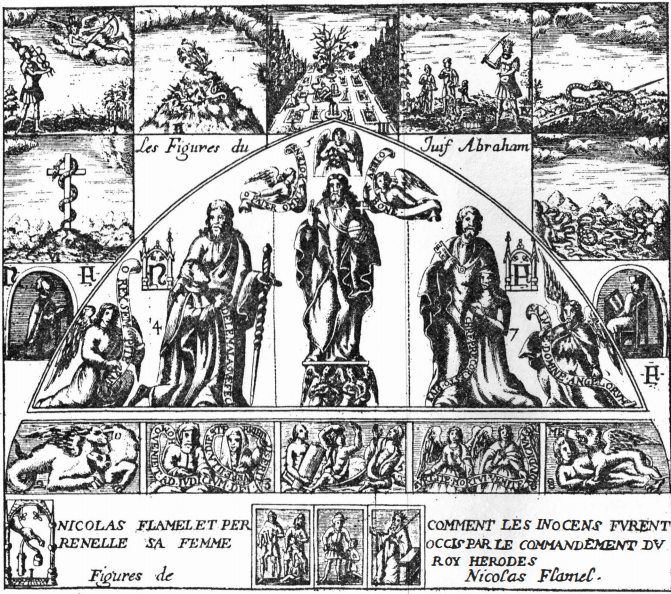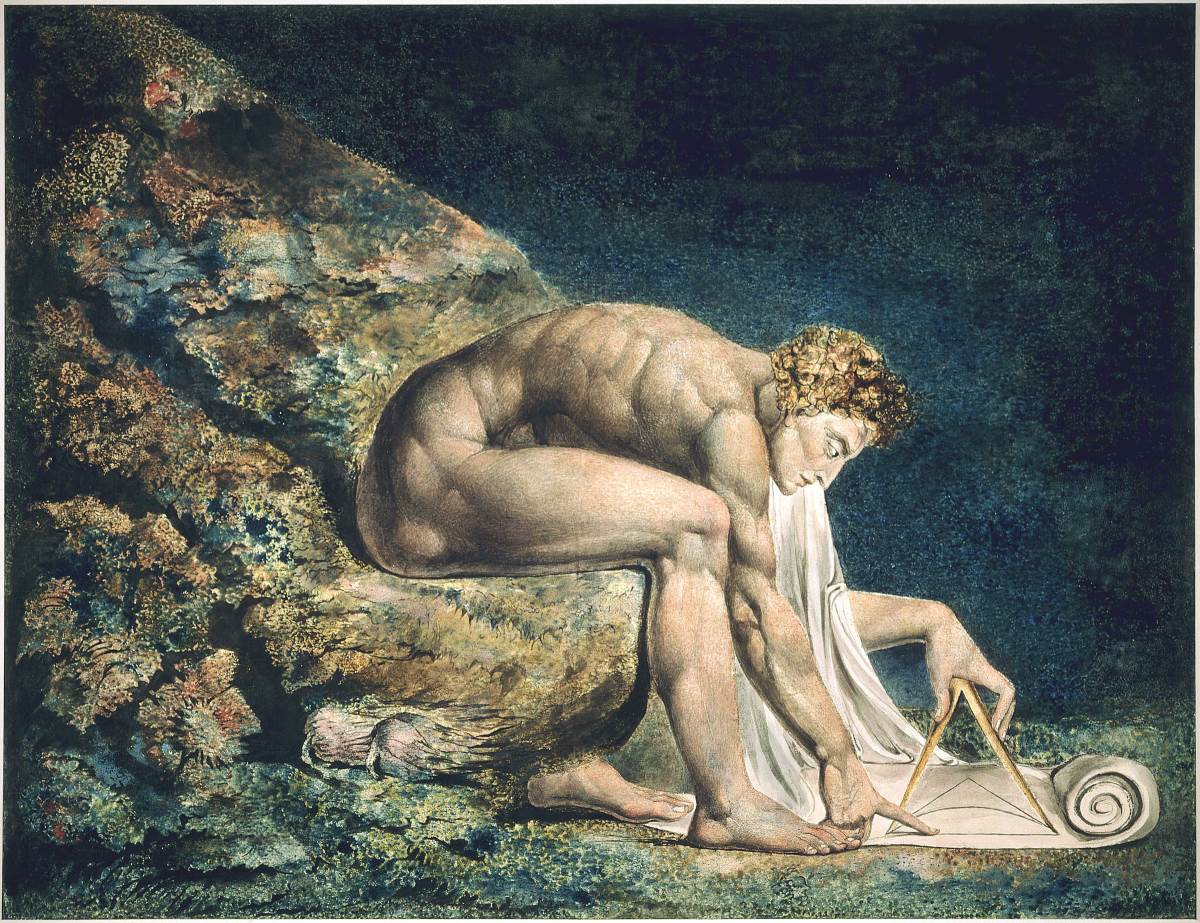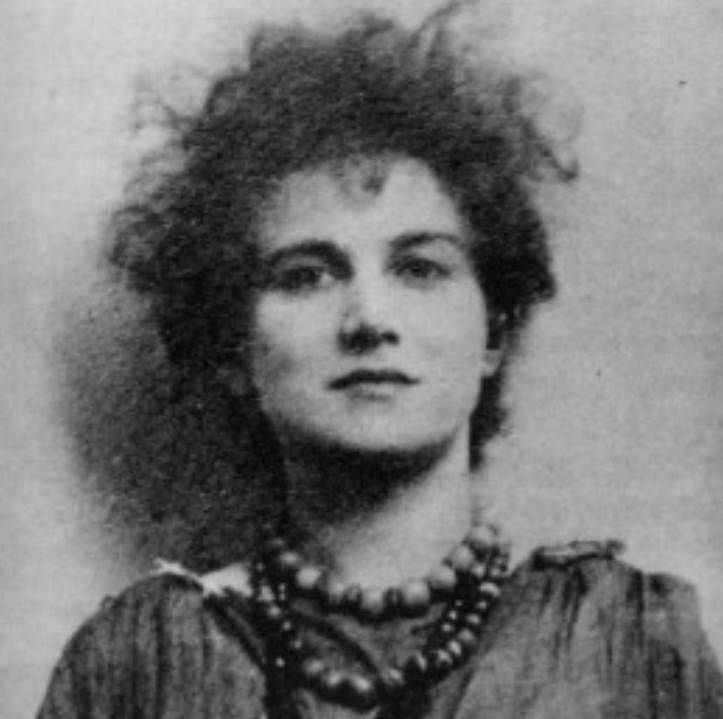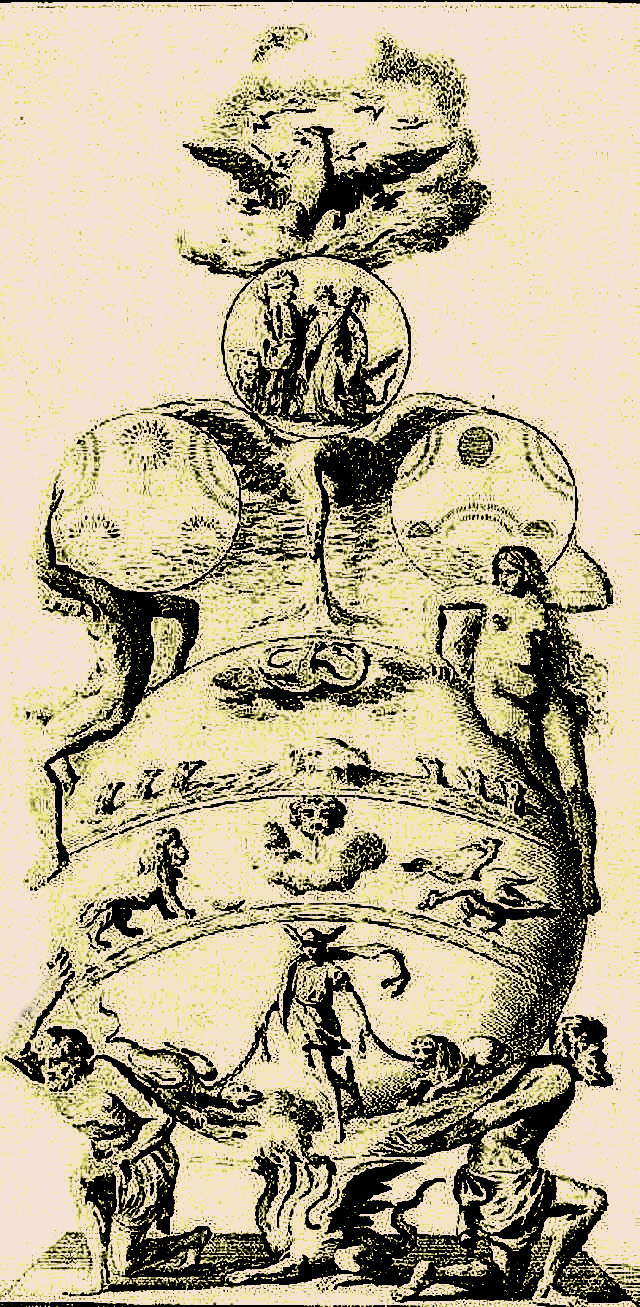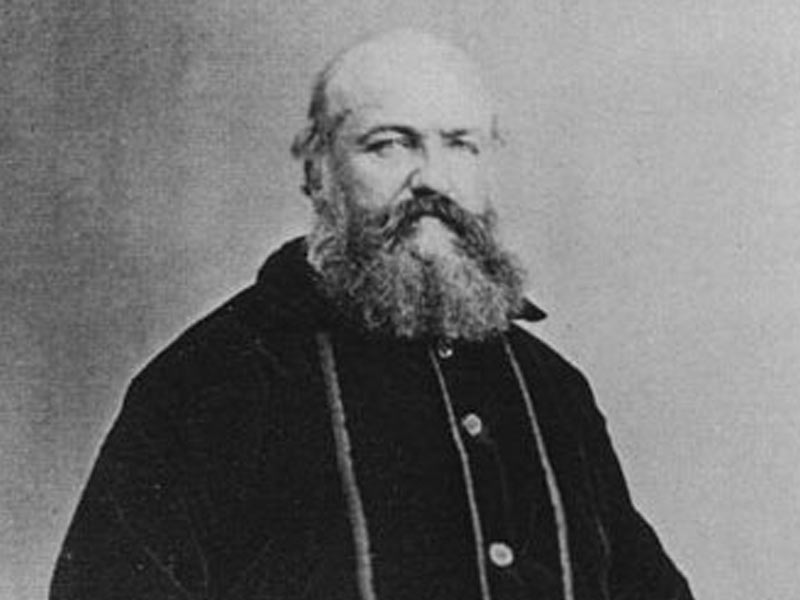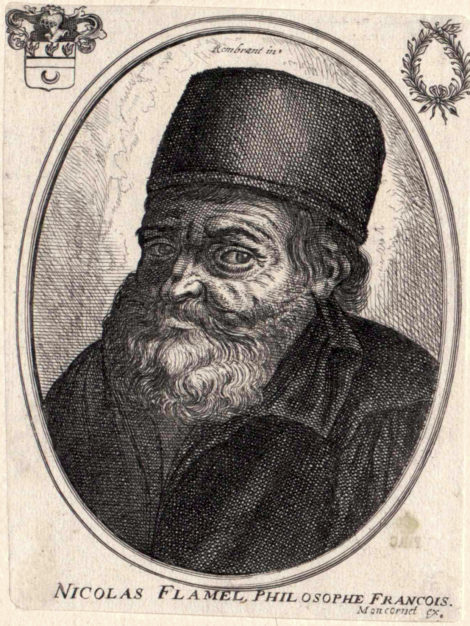
Portrait of alchemist Nicolas Flamel by the French painter Balthazar Montcornet from the 17th century.
At the core of any legend, there’s a dream. Such as a dream to turn any metal into gold, whether by touch or by other means, and the dream to live for as long as it is possible. But Nicholas Flamel’s dream was different. He did not dream of gold and immortality. Instead, he dreamt of a book, a book he could not read but which he was determined to decipher. In his dream, Flamel was visited by an angel who held a book in his hands and told him, “Look well at this book, Nicolas. At first, you will understand nothing in it, neither you nor any other man. But one day you will see in it that which no other man will be able to see.”
One day, when he was working alone in his shop, a stranger came to sell him a manuscript. Flamel recognized the book; it was the one he had dreamt of before, and he immediately bought it without bargaining. The book’s pages were grouped into three parts of seven pages each. He noticed Greek, Hebrew, and other writing he couldn’t recognize, as well as diagrams and symbols he couldn’t understand. His dream for the next 21 years would be to decipher this mysterious book. His quest for knowledge made him immortal, as in our minds today, he is still remembered as the alchemist who never died, the one who discovered the Philosopher’s Stone and the Elixir of Life.
The Life of an Alchemical Legend
In 1368, he married Perenelle, a widow who had married twice before and who had inherited the wealth of her former husbands. She was supposedly a little older than Flamel, she was intelligent, but most importantly, she was discreet enough to become his confidant and perhaps even his partner in alchemy. The Flamels were both Roman Catholic philanthropists who used much of their wealth to support the church. It is believed that their transmutations resulted in multiple charitable and generous acts all over Paris and Boulogne.
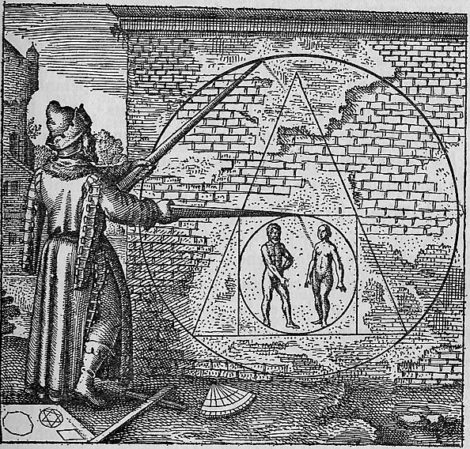
Engraving depicting the Philosopher’s Stone from Atalanta Fugiens by Michael Maier (1617).
Flamel’s life is a real mystery, just as much as his death is. It seems that the historical Flamel turned into an alchemical legend in the 17th century. That is because it was believed that he was successful in his quest to discover the Philosopher’s Stone and the Elixir of Life. But how did this belief appear in the first place?
Even though there is no real indication that the historical Flamel was as wealthy as the alchemical legend, perhaps some believed that his wealth and generosity were possible due to his knowledge of turning base metals into gold, and that his long life in a time when people frequently met untimely deaths was because he had discovered the Elixir of Life.
His legend may have been a hoax made by the publisher P. Arnauld de la Chevalerie, who wrote the book using the pseudonym Eiranaeus Orandus. While historians today tend to believe the hoax version, especially in the 17th and 18th centuries, people defended the validity of the book and the legend.
Alleged sightings of Flamel at the time reinforced the belief he was still alive due to the Elixir of Life, and some even suggested that the publishing of the book was orchestrated entirely by him, as he anticipated the ripples it would make.
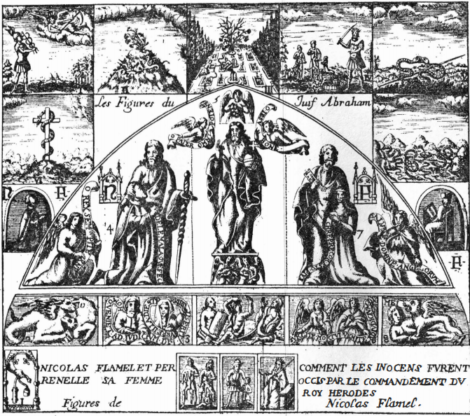
Alchemical hieroglyphics from the Book of Hieroglyphic Figures, attributed to Nicolas Flamel.
The story of Nicolas Flamel, as it appears, comes from a book published in Paris in 1612, titled Livre des figures hiéroglyphiques. The work presents itself as Flamel’s own long-lost composition, said to consist of designs he commissioned for a tympanum at the Cimetière des Innocents, which had already disappeared by the time of publication. According to the book’s introduction, written by the publisher, Flamel’s quest for the Philosopher’s Stone began with the acquisition of a mysterious 21-leaf book, the contents of which he had long tried to decipher. The story claimed that one night, he dreamt of an angel revealing a book to him, and shortly thereafter, a stranger sold him the very book.
To uncover the mystery, Flamel traveled to Santiago de Compostela in Spain in 1378, ostensibly on a pilgrimage, concealing the true purpose of his journey, to seek the assistance of an erudite Cabalist who could help translate the portions of his mysterious book written in Hebrew. Fortune favored him on the return trip when he encountered a sage who assisted in translating one of the book’s pages and revealed that the text in his possession was, in fact, a copy of the Book of Abramelin.

Page from the Book of Abramelin, published in 1725.
It is said that Flamel studied the book for 21 years, a year for each page. The Hebrew translation was believed to have enabled him and his wife to successfully uncover the instructions for obtaining the Philosopher’s Stone, with which they were able to produce silver in 1382, and gold soon after that.
Some constructions attributed to Flamel reinforce the belief that he might’ve indeed all of a sudden acquired wealth with which he was able to build estates, such as houses, churches, and hospitals.
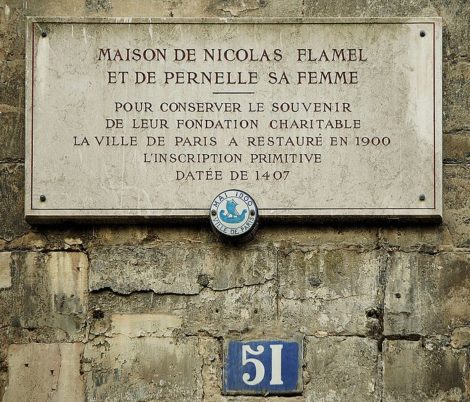
At 51 rue de Montmorency, Paris, the house of Nicolas Flamel is a historic monument.
One of the houses attributed to Nicolas Flamel stands since 1407 until today in Paris, at 51 Rue de Montmorency with its old inscription on the facade: “Nous homes et femes laboureurs demourans ou porche de ceste maison qui fut faite en l’an de grâce mil quatre cens et sept somes tenus chascun en droit soy dire tous les jours une paternostre et un ave maria en priant Dieu que sa grâce face pardon aus povres pescheurs trespasses Amen.” (We, ploughmen and women living at the porch of this house, built in 1407, are requested to say every day an ‘Our Father’ and an ‘Ave Maria’, praying God that His grace forgives poor and dead sinners.)
Although he was wealthy in the eyes of many, Flamel led a life of modesty and compassion, and the gold he had obtained with the Stone, he used only to help the poor and those in need. Historian Louis Figuier wrote: “Husband and wife lavished succor on the poor, founded hospitals, built or repaired cemeteries, restored the front of Saint Genevieve des Ardents and endowed the institution of the Quinze-Vingts, the blind inmates of which, in memory of this fact, came every year to the church of Saint Jacques la Boucherie to pray for their benefactor, a practice which continued until 1789.”
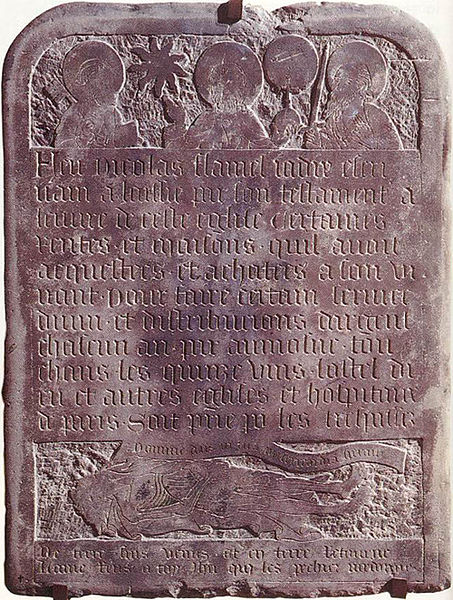
Flamel’s tombstone at Musée de Cluny in Paris. His grave is believed to be empty because he never died.
In 1397, Flamel’s wife, Perenelle, passed away. He continued to work on his manuscript business until his death. When he reached his 80s, in 1410, Flamel started preparing for his passing and designed his own tombstone. On it, there are carved images of Christ, St. Peter, St. Paul, as well as a sun above a key and a closed book in between the figures. Flamel then passed away in 1418. But his legend was just born.
The Quest Continues
After his passing, rumors spread that Flamel left clues about the formula of the Stone in his grave and other places of significance to him. Some believed that those clues would lead one to Flamel himself, who was still alive.
The rumors surrounding Flamel escalated in the 17th century, particularly following the publication of Livre des figures hiéroglyphiques and reports of him being seen alive more than 200 years after his death. During this period, many of his buildings were ransacked and damaged, and with them, any inscriptions, clues, or documents he may have left behind were likely lost.
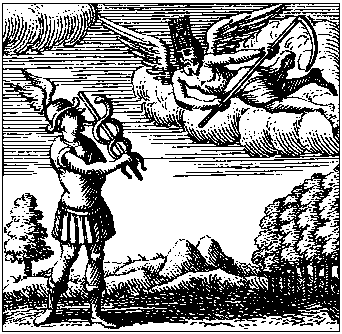
“God Mercury of the Pagans”, engraving from the Book of Hieroglyphic Figures, depicting Mercury and Death.
A document which is alleged to have been originally written by Flamel in 1414 in a “coded alphabet consisting of 96 letters” surfaced in 1750, when myths and sightings of Flamel were still circulating. In 1758, Monsieur de Saint Marc and his friend, Father Pernetti, decoded the document, which seemed to give instructions on how to make the Philosopher’s Stone:
“Take thou in the first place the eldest or first-born child of Saturn, not the vulgar, 9 parts; of the saber chalibs of the God of War, 4 parts. Put this latter into a crucible, and when it comes to a melting redness, cast therein the 9 parts of Saturn, and immediately this will redden the other. Cleanse thou carefully the filth that arises on the surface of the saturnia, with saltpetre and tartar, four or five times. The operation will be rightly done when thou seest upon the matter an astral sign like a star.”
More important than the Stone in this legend is Flamel, who is undoubtedly a fascinating figure, having made appearances in Isaac Newton‘s The Caduceus, the Dragons of Flammel, and Victor Hugo’s The Hunchback of Notre Dame. He continues to inspire alchemists, artists, and writers alike, who seek the stone in their own craft.


